According to a press release, Rolls-Royce has introduced new propulsion concepts for future military vehicles, focusing on hybrid technology and enhanced power output.
The company’s Power Systems division is expanding its mtu engine programme to include a hybrid powerpack and a 10-cylinder, 1,100 kW variant of the mtu Series 199, designed for tanks weighing up to 70 tons.
These innovations will debut at the Eurosatory defence trade fair in Paris from 17 to 21 June.
Dr Jörg Stratmann, CEO of Rolls-Royce Power Systems, highlighted the company’s commitment to its partnership with NATO countries and their allies.
“This underlines the importance we attach to our partnership with NATO countries and their allies in safeguarding their security interests. Because cooperation with the security authorities is one of Rolls-Royce’s strategic initiatives, we will continue to be a reliable partner as a supplier of propulsion systems for military vehicles with our decades of technological expertise,” he said.
The new hybrid concept offers significant tactical advantages, say the firm, by combining the strengths of a high-performance diesel engine with a battery-electric drive.
Knut Müller, Senior Vice President Global Governmental Business at Rolls-Royce Power Systems, noted the importance of these advancements:
“Future armoured military land vehicles will require more power for propulsion and on-board power supply for the electronic systems. At the same time, they will be designed for a different tactical approach in the field. Our future mtu propulsion solutions for this application take both of these requirements into account.”
Rolls-Royce’s hybrid drive integrates a customised silencer with the propulsion system, minimising noise and enhancing stealth, they add.


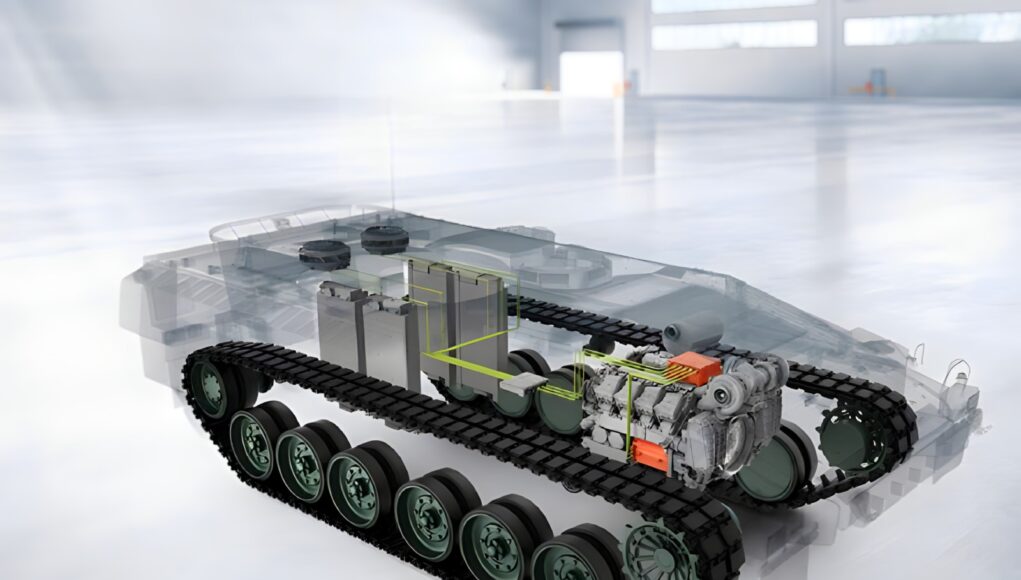

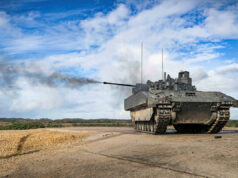
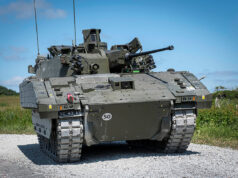


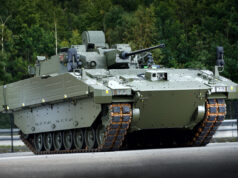



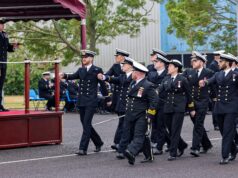

REME will need some seriously qualified people to maintain that in the field, Mr Moore?
Silence feature? Just wait for the Ajax upgrade 😉
Thanks Mr DB!
REME is very well used to maintaining complex equipment in the field from helicopters to radars, computers to self-propelled artillery. Interestingly we used to have the trade of Vehicle Electrician (VE) which was disbanded and now instead Vehicle Mechanics do a vehicle electrics module in Phase 2 training to become a Class 3 tradesman – I am sure they would brush up their vehicle electrics skills on their Class 3 to 2 upgrader and on their Class 2 to 1 upgrader courses.
Although, perhaps REME might bring back the VE trade?
An issue might be the safe carriage of replacement battery modules by RLC.
What they have against battery fires?
Probably a fire suppression system but to be fair most Tanks are built to keep flammable or explosives safe or contained / deflected. To be honest it’s not probably as big an issue in Military service as in civilian, a lot of issues with Lithium Battery fires are either down to poor charging facilities or folks messing around with them. Military tend to service / maintain properly and not bugger about trying to get a scooter to do 50mph.
Japan seems quite happy to use Lithium Batteries in their newest Submarines and USA have had an E M1 Abram’s.
Also, a lot of domestic cars have the battery in the floor pan or under some seats somewhere- under the boot if you’re lucky. I imagine that military types will be easier to access and pull out in a similar way to the rest of the Powerpack- meaning away from the crew area.
Yep and just look at the picture, their upright.
Indeed, nicely positioned for drop in replacement.
I also note the rubber band tracks, unless I’m mistaken. Likely nothing specifically to do with RR, but something I’d like to see the British Army looking into for Ajax and beyond.
Which means they can have a blast panel up.
Yeah, but most Tesla’s don’t have to deal with being shot at… Likewise, if a Japanese sub gets hit so badly a battery gets perforated, the enormous hole in the pressure hull is probably a bigger concern at that point. But in a tank, that’s expected to be shot at, if a piece of shrapnel pierces the battery, it will start a fire that is incredibly difficult to put out without it reigniting.
You’re going to have to armour the batteries like an ammunition compartment to reduce the chances of them being perforated in the first place & probably even have a mechanism to drop or eject damaged batteries to just let them burn away from the tank (as that will probably be lighter than the quantity of fire suppressant you would need).
That is unless we develop either less fire-prone solid state batteries or a fire extinguishing system that is much more effective against lithium battery fires before this type of hybrid system gets implemented.
Well he was talking about spontaneous Lithium Battery fires which seem to happen rather a lot, rather than being hit by an ATGW.
Besides which if you look at this engine, the concept and its background it’s pretty well obvious that GDLS are on board with the idea. Check out Abram X for details.
I’m aware that the Abrams X technology concept vehicle has also gone with a hybrid system… But so far it’s just that, a sales pitch, not an adopted vehicle.
There is generally a LOT of work and changes between concepts and what an army deems acceptable enough to risk the lives of their soldiers in (such as contingencies for firefighting lithium battery fires).
Also, based on General Dynamics’s recent track record for making an IFV that vibrates so badly it’s hazardous to the health of the unfortunate occupants, you’ll have to forgive me if I take what they’re on board with, with a healthy dose of scepticism.
AJAX isn’t an IFV.
Do you know what replaced the warrior? Is it the boxer? I’m a bit confused on the matter. I know the ajax is reconnaissance.
Hi Coll, I’m afraid the MOD isn’t currently replacing WR with a like for like vehicle. BOXER is the APC of choice (not mine!).
Thanks.
Dare I again refer to Boxer as ‘the Saracen of the 21st Century?’ There seem to be a lot of Boxer fanboys out there.
I’m not one of them Graham, certainly nit as an IFV replacement. I would out it past the MID to arm the damn thing with a Sallycan’s .303!
Cheers
Thanks Ian. I have yet to find out definitively what weapon(s) our Boxers will have in the RS4 RWS.
As you say Boxer is not an IFV so should not have been designated as an IFV replacement.
Agreed
BTW, I wish I could find the ‘O’ button in my phone🙄
On my phone!😡
Warrior IFV (and its variants) hasn’t been replaced yet, but it will be replaced soon (maybe from next year onwards, but the delivery programme is very slow) by Boxer APC (and its variants).
The Warrior upgrade programme got cancelled by the politicos and beancounters.
Ajax being recce/strike, together with variants, replaces CVR(T) Scimitar and variants.
Are any UK Boxer variants slated to receive a 20mm (or greater) cannon for direct fire support? 🤔
Not at present, but maybe in the future in a seperate tranche?
You never know.
Mayhap, the latest restaging of Beckett’s ‘Waiting for Godot’ by the MoD? 🤔😉
As Dern said, we must wait and see. So far Kongsberg RS4 PROTECTOR RWS has been ordered for Tranche 1 Boxers. RS4 can only take MGs, GMGs or ATGMs.
Understood, thanks. 👍
Please do we have to have this endless and mostly pointless revolving argument yet again.
I’d rather not too.
Well you can sceptical and that contract was a mess, but here we are with the same GDLS having beaten multiple other companies to gain the Booker M10 contract. Its baseline design is our Ajax with one less road wheel an upgraded version of the same engine and a 105mm gun.
Followed by the XM30 IFCV replacement for the M1 Bradley, last 2 in the competition are Rheinmettal with the Lynx and GDLS with……another variant of the Booker M10.
So either the US are stupid or the British Army just kept adding extra requirements to Ajax to the point it practically needed re designing.
The bit I really don’t get is Ajax is a recce vehicle and tracked replacement of just about every other light AFV. But under no circumstances can it be called an IFV.
Wheeled Boxer is the New British IFV !
But Ajax was developed from ASCOD which is an IFV, and GDLS has developed their competing design (which beat the CV10 and Tracked Boxer) for the XM30 replacement for the Bradley IFV from Ajax. And it is an IFV !
Mum and Dad were IFV 🦆, I look like an IFV but I’m not, but my Kids are all IFV 🦆
Figure that one out !
An IFV is: “an armoured combat vehicle which is designed and equipped primarily to transport a combat infantry squad, and which is armed with an integral or organic cannon of at least 20 millimeters calibre”
Ajax can provide direct fire support with a 40mm cannon, but it can’t carry a Section (squad), therefore it’s not an IFV.(Same way that CVRT wasn’t an IFV even though it provided the base for almost every single light AFV in the British Army for decades).
Boxer can carry a squad but it doesn’t have the capability to provide direct fire support with a 20mm+ canon so it’s not an IFV. It’s an APC.
AFV classifications are not monophyletic taxonomy, they are defined by capability and role, not by what the chassis was developed from (Or we’d have to classify CRAAV, and Trojan as MBTs).
You absolutely could make a version of Ajax that is an IFV, you just need to create space in the back for a section of infantry (“just”), and you can absolutely make a version of Boxer that’s an IFV, you “just” have to mount a IFV claiber weapon on it.
Dern,
Damn, ‘monophyletic taxonomy’! 😁👍
Too quote Jumanji; Welcome to the Jungle:
“Zoology b*tches!”
😂😁
I thought Ajax had space carry up to 7 (plus a crew of 3)?
It seems most modern IFVs can’t carry a full squad & have to be split between 2 vehicles (Bradley I think can only carry 6 these days, same with Puma).
ARES carries 4 dismounts plus 2 crew.
No, Ajax doesn’t have space for any dismounts. Ares, as Ian said carries a team of specialists, but Ares doesn’t have a turret so it’s not a IFV either.
And you’re also wrong about modern IFV’s carrying “half squads.” A squad (or section) is the smallest unit of manuever in a modern army, and usually consists of about 8-12 people. You’re looking at the passenger load and thinking “Well that’s not a full squad.” And forgetting that the crew is part of the section. Unlike APC’s, IFV’s are an integral part of the combat strength of their section (because they have direct fires).
Where in a light role unit the section commander might command one fire team, and the 2IC the other, with an IFV the breakdown typically is one of them commands the dismounts, and the other the vehicle. (Exact organisation differs nation to nation). But it’s not like a section commander is sitting in a IFV thinking about “half his section” in another vehicle.
Why would Ajax be designed to carry 7 dismounts? – it is a recce vehicle, not an IFV.
Totally agree with you the argument over Ajax is a pointless one. That said from what I read even though GD originally posed an Ajax derived design for the US contract it will have little in common by the time it’s delivered. However that simply proves it can become an IFV if you wish it and came from one generations back too.
It’s not exactly pointless if you want to move an infantry company and you get vehicles that can’t carry them.
😁
Glad someone got it ! To be honest I reckon the US Army will pick the GDLS option simply because of all the synergies with the M10 Booker. Plus Lynx is well just too German !
The same M10 Booker that’s apparently been gassing its crew when it fires its gun?
As I said, not the best recent track record when it comes to AFVs.
I presume you mean the M2 Bradley (they skipped the model 1, not to get it confused with the Abrams).
Actually, the Army refers to the Boxer as a “Mechanised Infantry Vehicle” (MIV), what’s wrong with calling it an APC, I don’t know, but MIV is apparently the fashionable new term for a mine-resistant APC (usually wheeled)… Though nobody is still making non-mine-resistant APCs, so why the need for the distinction?
As far as I can tell, the Britsh army is giving up having an “IFV”, not sure why… But as you say, they insist the Ajax is a scout vehicle.
What I’m confused by is nobody seems to have told General Dynamics… As the requirements were essentially for an IFV and they’ve definitely designed an IFV… But it’s NOT an IFV. Go figure.
I feel like if they really wanted a scout vehicle to replace the Scorpion and Scimitar (both ~8-tonne vehicles)… Why is it 38 tonnes and can carry 7 dismounts? Why is it not SMALL or wheeled, like the French Jaguar?
I can’t help but think that “Protected Mobility Reconnaissance Support” is to IFV, what MIV is to APC. Maybe they’re deliberately trying to change doctrine, or maybe it’s just the new hip term to try to seem “modern”.
It kind of seems like we could have done with an IFV and Scout car which share a turret (could be the 40mm CTA one or else an unmanned turret like the Puma, more suited to anti-drone use). And then a wheeled APC, like the Boxer (though again, with the remote weapons station being upgraded from a 12.7mm to something like a lightweight 30mm M230 for anti-drone self-defence).
So, Jaguar isn’t small. It’s 7mx3mx3m (longer with the gun). Ajax by comparison is 7mx3.3mx3.2m with it’s side armour. Ajax is *heavier* but that’s mostly down to protection requirements.
MIV is not a vehicle classification (nor is PMRS but we’ll get to that). MIV was a program name (before Boxer was selected, so it could have been any vehicle) rather than a vehicle type and it’s just kind of stuck around.
The British Army has given up on actual IFV’s because of a funding black hole. Warrior is no longer fit for service due to lack of upgrades, and there wasn’t enough money in the budget for the program to imporve it, so it’s being withdrawn from service while the MIV program goes ahead.
Ajax is IFV like because it’s based off a IFV hull. GDUK didn’t “design a vehicle that is like an IFV but not an IFV” they took an IFV and turned it into a Recce Vehicle.
PMRS isn’t Ajax, or even the program name for Ajax. PMRS is the prototype for Ares, the troop carrying turretless version of Ajax. It’s not a “new modern hip term.” It was a specific classification to distinguish the support variant from the scout variant before the army settled on names (Ares and Ajax) for the variants.
And you are right about the turret, the plan was for Ajax and Warrior both to have a 40mm turret with the new upgrades, but there wasn’t enough money in the budget to upgrade Warrior, so that program was cut.
I forget how large Jaguar is. Though I think the hull is somewhat shorter, certainly its silhouette seems smaller. It does seem like that particular vehicle is also unnecessarily large.
Right, so General Dynamics DID set out to design an IFV in the ASCOD, based on the requirements for an IFV (by Spain and Austria) then created a recce version to UK requirements… Hence why it has all the characteristics of an IFV.
Surely, the benefit of using an IFV as the basis for your recce vehicle, is to save money by using a common vehicle, maybe add a few systems (modern IFVs already require basically everything a recce vehicle needs anyway) and drop the requirement for troop transit, using the space for something like missiles (like on the M3 Bradley) or having an extra drone operator (and drones) in the back.
If you’re going to get a completely separate vehicle, why get one that is so compromised because of the IFV background?
A funding black hole? Yet somehow we spent (more like wasted) £430m on Warrior CSP! I know sunk cost blah blah blah, but why are we waiting until AFTER we spent the money to can these projects? We could have bought over 70 more Ajax-like (only with seats in the back) vehicles for that. Or probably could have bought 120-150 Ajax turrets and retrofitted them onto Warrior hulls.
As for the variants you mentioned, why is Apollo and Atlas (both used for recovering/repairing vehicles) not just 1 vehicle? And now they’ve given up on Ares being a proper APC either, why that’s a separate vehicle from Argus (both transport for specialist teams, at least I’m assuming that’s what’s meant by “engineering reconnaissance”)?
So we have 6 variants of the vehicle… None of which are an IFV, or an APC, or a SHORAD to replace Stormer, or a mine clearance vehicle or an EW vehicle, but still we have 6 variants somehow.
I’m sure the dismount space behind the turret is still there from the ASCOD, They certainly haven’t made the vehicle any smaller! So we could have put the 6 or 7 seats back in and have Ajax pull double-duty as an IFV and recce vehicle, have recovery/repair version, an engineering and mine-clearing version, a command version and an AA version (and if you need yet another APC, then an APC version).
Probably because you don’t see them side by side (or often even next to people), and Ajax is chunker than Jaguar, and 20cm taller. Unfortunately size is the price you pay to have a modern sensor package, decent protection, and a medium caliber gun (M3 Bradley also comes in at a similar size).
A few corrections; General Dynamics did NOT set out to design an IFV in ASCOD, because General Dynamics did not design ASCOD. It was a corporation (the COD part of ASCOD) between Steyr and Santa Barbara. GD eventually bought SB (which is where they got the legal ability to use the design as a base for Ajax), but not before the design was all but finalised. So it’s more a case of GD happened to have this IFV design that they’d bought years ago and could adapt to a Recce Vehicle function.
I’m not sure why you think Ajax is compromised by being based on ASCOD?
Yes a funding black hole, in general the UK equipment plan is very over budget, and between Warrior CSP going over budget, Ajax going over budget, and Boxer needing to be funded, the choice was made to go with buying the two modern vehicle fleets, rather than try to keep a 50 year old vehicle in service with an update.
Okay, so a load of questions. Cool!
I won’t go through and answer each question in order, I’ll try instead to make a more coherent response.
So the thing is Ares, Athena, Apollo, Atlas and Argus are both essentially PMRS with different things added on. So when you’re asking “Why did we develop this different vehicle” it’s really the same vehicle with the space inside it utilized in different ways and different things stuck on the outside.
Ares was never intended to be a full on APC, the British Army was not looking at creating a Mechanised Infantry Battalion on a tracked APC. What they wanted was a Support Vehicle that would be part of the Formation Reconnaissance Regiments, transporting small teams of specialists, notably ATGM teams.
Argus differs in that Engineering Recce might require them to do some light route clearance, rather than calling in heavier assets. So Argus is a PMRS with a heavy bulldozer blade, and, presumably since Argus only carries a single Sapper in the rear, the back used for storing engineering equipment such as PE, sledgehammers, etc.
Apollo is the Repair variant, Atlas is the recovery variant. You need slightly different load outs to recover a vehicle that has bogged down, or broken down (think vehicle extraction kits, bulldozer blades, extra towing cables, etc) than to repair a vehicle (think cranes for lifting power packs out).
You seem annoyed that none of the “Ajax family” is an IFV, or and APC, but that’s not what the Army was buying, the army was looking at re-equipping it’s formation recce regiments.
Ajax does not have space for dismounts. Scout SV, which was the pre production variant, had space for one seat for a single dismount in the back (it was removed from the final production Ajax as I said below in a response to Graham, because there is no way that you’d set down a lone soldier as a dismount, even a drone operator would need a team for protection). This is because Ajax is not ASCOD. It is just *based* on ASCOD. Same as M10 Booker is (and that also doesn’t have space in the back for dismounts). That’s in part because Ajax has a much larger turret than ASCOD, and in part because the old crew space is largely used for communications and sensor kit in Ajax (or storage in the case of the single seat that was left in Scout SV). Removing the recce specific equipment might be relatively easy, but getting a new smaller diameter turret really wouldn’t be. So it’s not a simple fix.
The British Army wrote a clear requirement for a Specialist Vehicle (Scout SV) vehicle to replace Scimitar – the contract went to GDUK. They were not told to build an IFV – they were told to build a recce vehicle, as Scimitar was a recce veh.
I have no idea why you think ‘the requirements were essentially for an IFV and they’ve definitely designed an IFV’ – not the case at all. Ajax is a recce vehicle – it has a 3-man crew and carries a ton of surveillance sensors and specialist comms fit – it does not carry a 8-man infantry section. It does not carry 7 dismounts – recce vehs don’t need that – it is PMRS (ARES) that carries 7 dismounts.
It is 38 tonnes because that reflects the amount of armour required to meet the protection remit…and also because they started from a larger base vehicle than Scimitar was.
An IFV is an Infantry Fighting Vehicle – it has a cannon and carries 7 dismounts and in the Warrior era the commander can dismount too. Ajax does not do that. It is a recce vehicle. Totally different role and has a different place on the battle field to the IFV.
The British Army has been forced to give up operating an IFV as the upgraded Warrior programme (WCSP) was cancelled by the politicos for monetary reasons. S*it happens. The army has therefore been forced into fielding Boxer APC (winner of the MIV programme) in its place in the armoured brigades – no-one with any sense thinks that is a good idea, but there is now no budget for an IFV.
The original PMRS had space for 7 dismounts, but PMRS was then altered slightly into different forms (Ares, Athena, Argus, Apollo and Atlas).
Out of those, none of them are required to carry more than a crew of two and four dismounts, so the dismount space got redesigned for various things.
So:
Scout SV: 3 Crew, 1 dismount
Ajax: 3 Crew, No dismounts.
PMRS: 2 crew, 7 Dismounts.
Ares: 2 crew, 4 dismounts
Athena: 2 crew, 4 dismounts
Argus/Atlas/Apollo: 2 crew, 1 operator
*notes: Scout SV had a seat in the rear, that was replaced with ammo stowage in the production Ajax because there was, and is, no call for a single dismount.
Athena is a Command and Control variant and much of the rear is taken up by work stations.
Argus/Atlas/Apollo I don’t know if they actually used the dismount space for anything, or if the Engineering Operator just has a palace to himself in the rear.
Dern, absolute gold. Many thanks for the detailed info.
I had to smile at the thought that ‘the Engineering Operator’ in the case of the REME variants ATLAS and APOLLO, probably a VM junior rank, occupied a palace in the back. Any random space in the back will be crammed full of REME Special-To-Role kit.
ARGUS is the Sapper’s Engr Recce variant I believe.
Okay, how is it different IN DESIGN (not in intended role) from say, an M2 Bradley? Which ton of surveillance sensors and specialist comms fit” does Ajax have but the M2 doesn’t?
Sure the US has the M3 variant of the Bradley family intended to be an armoured reconnaissance vehicle, but in terms of differences, they removed a bench inside to increase the capacity for TOW missiles… That was about it, the base M2 (definitely an IFV) vehicle is perfectly capable of reconnaissance (as Ukraine has proved).
Why does a Scout vehicle have a void the size of a passenger compartment behind the turret… As an IFV would?
And no, it’s not 38 tonnes because of the armour requirements, it’s that heavy because it’s the size of a house! So because they have to protect a house, not a small recce vehicle, it requires far more area/weight of armour. Seriously, it’s a meter longer than a Bradley (as well as being taller and wider), and that vehicle was mocked for being too large to be a recce vehicle! I cannot comprehend what they were thinking, other than turning a pretty standard IFV design into a recce vehicle (as the US did to the M2 in making the M3… Only Ajax doesn’t even use the extra space for missiles).
Procurement in the UK is fubar! They seem to spend half the project budget trying to reinvent the wheel, only to come up with a 200-sided shape because then they can’t admit that they wasted time & money and that round was the best shape after all.
I would quite like to know who had the idea of replacing an IFV (Warrior) with an APC (Boxer)… Rather than an actual IFV (like the ASCOD vehicle Ajax is based off, or CV90, Puma etc).
You are right that the M3 CFV is only subtly different to the M2 IFV, and that one of those differences is the removal of the right hand seats to accomodate additional TOW missiles. The US has the philosophy of conducting recce by fighting so the CFV is well armed and carries more tOW and more 25mm and 7.62mm than the M2 IFV.
The UK has traditionally conducted recce by stealth so had small, fast recce vehicles with a primary weapon largely for self-defence.
The UK/US TRACER project probably did more to persuade the British Army to lean more towards the US philosophy, so perhaps it was no surprise that an IFV (ASCOD2) was picked as the departure point for GDUK’s design (as did BAE, its rival). But the changes made to ASCOD 2 Ulan/Pizarro design have been very significant. Ajax is 80 cm longer, 30cm narrower and and nearly 60cm higher. It would be tedious to list all the differences. Compared to Pizarro, Ajax is 38-42t rather than 26t. The larger length and height of Ajax accounts for some of that but the BA has clearly specified a higher level of protection than Spain and Austria did, otherwise it would weigh about 32-34t.
It is difficult to pin down the details of the sensor suite on Ajax – both MoD and GDUK seem to be reticent to share the details in Open Source. It is also difficult to find any schematics or photos of the interior layout of Ajax. I too would be interested to see how internal rear space has been utilised, but it will clearly be in furtherance of the recce task.
Any vehicle is capable of reconnaissance – we are now using ‘spare’ Warriors to replace Scimitars as an interim measure until Ajax is definitively fielded. I conducted recce for new workshop positions from the passengers seat of a LandRover, admittedly a different type of recce! But ‘any vehicle’ would not be optimised. A vehicle in the recce role does not want to be carting an infantry section around.
I totally agree that the GDUK approach was a very odd one – and it is no surprise that major difficulties were encountered. There was clearly a determination to start with a fully devloped GD product, ASCOD2 IFV.
I have mentioned many times why Warrior IFV has been replaced by Boxer APC – it is all about money and politics. It is clearly not because the army thought it was a good idea.
Yeah the M2/M3 CFV design choices stem from a time when a Recce Commander only needed a 25mm, and his commander sight to do Recce. Obviously you still can do that, but the modern EW space is such that a commander can gain significantly more infomration if he’s equipped to monitor it, plus he can use his scouts to significantly constrain his opponent. Hard to use your comms if you know there’s a recce screen out there actively hunting your EW signature.
Tbh the only real question mark I have over Ajax is why it doesn’t have a mast, maybe compromises in how “fighty” that would leave the platform?
Sh*t dit: We once used a white fleet vehicle that was supposed to be non-tac to do a stand off recce of an enemy position on an OTX. The OM’s where well annoyed because they wanted us to CTR the position, but even if the OpFor had spotted us, we could have left and been three villages over by the time their foot patrol had gotten in small arms range. So yes, you absolutely can use any vehicle to do Recce. But a purpose built modern platform is just BETTER for it.
I agree that it is puzzling after all the hacking about with the ASCOD2 design that Ajax did not include a mast.
I served with Canadian Forces (NATO Exchange) and they were proud of COYOTE ‘light recce veh’ based on wheeled LAV-25 and in service from 1996 (nearly 30 years ago!). There are 3 variants – standard recce wagon; one with with remote sensors or a version with telescopic mast elevating sensors to 10m above the ground.
The ‘Mast version’ carries atop the mast, the AN/PPS-5C MSTAR v.3 surface surveillance radar, an EO/IR surveillance system with a long-range video camera and laser rangefinder.
Yeah, and I wish I had an answer, or that I could get the opinion of someone who was in the decision making chain about why they felt a mast was surplus to requirements or a draw back. I mean, I can theorise, but I’d like to know.
I just think it’s funny that the lack of mast is one of the few justified complaints that you can really level at Ajax’s design, and it just seems to be the one thing nobody ever complains about.
👍
(Always find it interesting at what point people stop replying in threads like these).
Me too!
So just to add a few points to what Graham has already said (and very little disagreements with his points)
The design differences between M2 and M3 Bradley are nowhere near as intensive as the design changes between ASCOD and Ajax. The M2 to M3 change was minimal, just trying to make the Bradley more of a unescorted fighting vehicle, rather than a launching and support platform to for dismounts, while Ajax was a more more significant ground up redesign. One of the chief differences is, as I mentioned, the turret, which on Ajax is significantly larger.
Obviously Ajax doesn’t eliminate a bench for a few extra TOW/ATGM launchers, because Ajax doesn’t have the ability to fire ATGMs (Doctrinally Ajax is, as I said, supported by Ares vehicles carrying ATGM teams, typically at a scale of 1 Ares for 3 Ajax). Instead what space isn’t taken up by the turrets is taken up by the sensor fit, and as Graham said, it’s pretty hard to get details on that for good reason. But most modern recce vehicles have the ability to passively or actively collect SIGINT (essentially to sit in a field and pic up radio traffic, then extrapolate enemy positions and strengths from that signal, and potentially call in fires if deemed appropriate). I want to emphasise this because a big difference between a 1980’s designed M3 Bradley CFV and a modern Recce Asset is that a Bradley commander (or CVRT for that matter) will only really be able to use his optics and mk I eyeball, while his radio is limited to transmitting his voice.
Additionally, and I want to stress this is idle speculation on my part, I’d imagine that Ajax would carry a s*dding massive APU, battery bank and ECM so that it can both disrupt, and so that it can operate without using it’s loud IC engine for long periods when in an OP.
Booker M10 is of course a fire support vehicle to support mech infantry, not armoured infantry (the US Army is desperate not to call it a light tank but the media does; other choose to call it an assault gun).
Ajax is of course a recce/strike vehicle.
The Requirements for Booker M10 and Ajax are totally different. Chalk and cheese.
Not sure why you think the British Army just kept adding extra requirements to Ajax. They will have set out their Requirements in a Requirements document – both GDLS and BAE bid for the contract and the former won.
In any long devlopment programme Requirements can change for multiple valid reasons (the Threat can change, materials science can change, other technologies evolve and mature, TTPs change etc). Ajax is notaboe in that only once did the Requirments change (in 2016 I believe) and Contract Amendment action was taken.
Where army staff can be criticised is that they allegedly were very proscriptive when writing the Requirements document, but I have seen no evidence myself of this. If they were proscriptive that is very old school. (Although one proscriptive requirement was that it had to have the 40mm CTAS cannon which was GFE).
Wheeled Boxer is of course no IFV…as it lacks a cannon, but it is being forced to replace an IFV (Warrior). Wheeled Boxer equipped with just a MG is a mere APC, not an IFV. It is the cannon or lack thereof that differentiates an IFV from a APC.
I don’t get why you are puzzled that Ajax is not called an IFV. It is not an IFV as it is not an Infantry Fighting Vehicle – it does not carry an 8-man infantry rifle section. It is a recce/strike vehicle. Totally different role. Ajax is of course an AFV as it is Armoured, does Fighting and is a Vehicle. It’s just not an IFV as it does not carry an infantry section.
I am puzzled that you are puzzled!
You don’t get to an acceptable end solution unless you invest in the principle, develop it, exhaustingly test it and plan for production so you start now to get to where you want to be some years down the line. If you don’t do it someone else will, which sadly has often been to the detriment of British Industry. At least RR is doing it along with German Industry.
I’m not saying it’s not the better power-pack, I just take issue with “To be honest it’s not probably as big an issue in Military service as in civilian…” as use in an AFV introduces a whole lot of new problems the engineers trying to implement it are going to have to deal with, and as an engineer any time people say stuff like that or the dreaded “just…” I get PTSD.
It’s a myth that lithium batteries catch fire a lot! Check out real data and you will see the truth.
FYI. The MSM will report an EV battery fire to get sensational news clicks, even though they are statistically very rare.
There are literally millions of EV’S around the globe now with hardly any issues and when there is an issue it is quite often the case that the user has done something really dumb to cause it
As I say above solid state batteries are under stage 2 testing with car manufacturers which means they are of production quality being tested in real time in vehicles to prove they are ready for prime time. Sodium which are ultra safe are also an option moving forward so it seems sensible to start equally building for prime time with the hybrid drive system to exploit them too so that manufacturers can plan for their future vehicles probably towards the end of the decade. Generally speaking sodium and lithium batteries are inter swappable and can even be built on the same production line.
As I recollect most submarines have batteries outside the pressure hull as protection. Yes a lithium battery with a metal projectile stuck in it will short and get hot, this can be contained though. Don’t forget musk is interested only in a fat pay check not in making a safe car, our civil service is more interested in a dull back poclet
Do you mean they use the batteries as some kind of spaced armour?
No, that would be a very bad idea… Imagine if the battery shorted during a dive because it’s on the outside & exposed to seawater under immense pressure (or the sub hit an uncharted underwater mountain like the USS Connecticut did)… The power would fail and they would lose control of the boat.
Almost all, including the Soryu’s, have them inside the pressure hull, keeping the high-voltage electrics away from the salt water or impacts, and as low down inside the hull as they can get for stability (as batteries are very heavy, even lithium-ion ones).
They have them pretty much like in this cutaway.
https://www.secretprojects.co.uk/data/attachments/202/202332-345385f9cb8ec15e4a1abf182364c932.jpg
I know the German U Boats had them inside at the bottom, but I have read elsewhere that some of the subs have them outside. I guess it depends if you have them all outside an if they are all in a singe outside place that will flood on the first dent or whether you have designed it have sensibly so that in the event of a problem you isolate a small percentage of your overall supply
Do you recall which subs have them on the outside? Only that would make for interesting reading.
The problem of putting them on the outside is you somehow have to keep the high-voltage electrics away from the salt-water, which means putting them in some kind of water-proof container… If that water-proof container isn’t the pressure hull, you need to make a battery box that can withstand something like 6 megapascals of ambient pressure (I don’t like to think what 6 MPa would do to Li-Io batteries). This basically forces you to make your pressure vessel a cylinder (else it would be extremely heavy) and that then creates volumetric problems to fit a whole lot of battery-containing cylinders between the pressure hull and the hydrodynamic casing. Even on a double-hulled submarine, usually, the inner one is the pressure hull and the space between is free-flood.
Or you could just put them under the floor of the lowest deck inside the pressure hull…
Sadly no, I thought it was some russian one but I cant find the info now (I did look last night) so it is entirely possible that I was actually mistaken in which case sorry is best. Though I think it would make sense as long as it was done properly (as you rightly say if it was just one compartment and if they were connected without fuses etc etc it would be a problem. But done right its just an extra layer of protection and on a sub the cold water is going to dampen even a lithium fire
Plus this is the beginning of the transformation to hybrid systems and we have solid state Lithium batteries already at stage 2 testing with Mercedes amongst others and other similarly even safer technologies like sodium replacing Lithium advancing well though still not up to Lithium densities, but can be charged potentially in minutes safely. Other longer term alternatives exist too. So I expect when they start to take off the safety aspect will be improving all the time.
If these batteries are Lithium-ion (Li-ion), then certain precautions need to be taken to minimise the chance of thermal runaway which can cause batteries to explode or burn ferociously (I doubt the current in-service on-board fire-fighting system would be adequate).
Some Li-ion batteries are more pron eto thermal runaway than others.
You are of course correct, but like many other things that have had issues they get mitigated during the development process. I suspect you and I would just love to actually see this in the flesh because it is such a change in tech.
I’ve said before Land Stuff is not my thing, but I do have a question for you.
If this is a move away from conventional direct drive via driveshafts / transmission to a Diesel Electric / Hybrid could you have 4 drive sprockets ?
I think it is perfectly possible to move to 4 x electric motor final drives for AFVs and can see some advantages – reduced stresses on the tracks and greater propulsive redundancy. Diesel-electric hybrid would have advantages – some fuel savings and hence smaller fuel tanks, elimination of mechanical gearbox and its efficiency losses, and possibly quieter running.
A key issue will be finding enough safe space under armour for the very large battery pack(s) – perhaps it could go in the space currently occupied by the mechanical transmission but that is a hot area and it would shift centre of mass of the hull from that depicted in the schematic.
Many ships have electric drive (integrated electric propulsion) – I sailed on Queen Mary 2 many years ago (designed over 20 yrs ago) and T45 and our carriers have this too.
Maybe it is time for AFVs to enjoy the benefits.
Don’t buy cheap Chinese replacements and leave them charging overnight…
Nah who am I kidding of course they will as they are cheap….
China is the most advanced country in batteries development…
Because the fashionable luxury beliefs of decadent western political-journalist class don’t like “dirty stuff” so we pay the price.
I’m guessing flame venting similar to what they have for ammunition fires?
As you say….To deal with ammunition explosions in the turret bustle some tanks have blow-off or blow-out panels to direct the force of the explosion away from turret crew.
In theory you could provide blow-off panels above the battery pack to deal with battery explosions, but the explosive energy could still go sideways and downwards towards the crew.
Battery fire is more common than large explosions and venting flames skywards would only help a little – flames would spread sideways too. The in-service on-board fire extinguishing system would probably not be good enough to deal with a fire in a very large battery pack.
Battery fires are far less common than people think and in fact fuel fires are far more common. Batteries are also managed far better today and do not need to be made in china with lithium chemistry (new battery types are now available) . Yes they need to be managed for short circuits but they can be distributed, there can be multiple drive motors and better armoured protection without exhausts and radiators exposed in the way they are today
The thing about a battery fire though is that it is next to impossible to extinguish it by conventional means.
That depends on the battery chemistry in use and of course how they are cooled and interconnected. Cheap and nasty Chinese batteries in overpriced but cheap, nasty and usually shoddy Chinese imports with flash badges (BMW, Merc, MG etc) should not be used as a benchmark for a whole technology.
3M are developing an electrolyte that is fire proof. No more exploding batteries.
https://newatlas.com/energy/self-extinguishing-lithium-batterty/
No great surprise that RR Power Systems are looking at this, power packs for AFV are pretty well their Bread and Butter land product.
Tanks are getting heavier, more power needed, better fuel consumption, emissions, increased electric load requirements and a possible quiet creep mode.
It’s worth reading the Original Article on the RR company site, as it gives more detail. Just go onto RR Power Systems select Media and drop down tick box Power Systems.
What’s lacking is the detail so I don’t see if they are using a conventional transmission, hybrid drive or battery assisted Diesel / Electric.
Not necessarily getting heavier, case in point Panther KF51.
I did read that the US found that the active Israeli derived defensive set up on ground vehicles they were playing with had a less than 50% success rate due to limited electrical power whereas since updating the power generation they got it up to 75%. Still less than ideal but shows how much power future fighting vehicles are going to need that’s certain so hybrid systems are going to be vital I suspect.
I hope that future tanks (after CR3 etc) will be somewhat lighter.
This may just tick that Box.
There will be a weight saving in that mechanical transmission is dispensed with, and fuel tanks might be smaller but there is the added weight of the battery pack.
This is the sort of thing that I am on about when I have previously proposed in other postings that the UK should grasp the current opportunity of coming up with a world-beating, dominant MBT and other heavy armoured vehicles, as part of national rebuild capabilities strategy.
I do wonder if this is aimed at GDLS and their idea of Abram’s X to replace the current M1 versions about 2 years ago. It needed an Hybrid Diesel and I can’t think of any US Diesel maker who could come up with a better option than MTU.
Its a V10 version of the Series 199 RR MTU engine which are a commercial modular engine built in various V cylinder configurations. They’re built here in UK and in Germany and very widely used as power packs for AFV.
I read both Press releases of RR Power Systems and GDLS side by side and they have a hell of a lot in common.
The US has pretty well squeezed every drop of growth out of the existing M1 and badly need a better Tank. There are a lot of good features in the M1 but the limiting issue is the existing engine. It just doesn’t have any growth room left, guzzles fuel, is maintenance heavy and can’t generate more Electric power.
What makes life worse is the US Army badly do need a better MBT, but have neither the time (8 / 10 years) nor the money to launch a completely new Development programme.
GDLS came up with Abrams X which fits the bill quite nicely, is a remodeling, update and upgrade rather than a clean sheet design (so affordable). But it needs a suitable Hybrid Engine and 2 years later this ticks all the boxes including costs and simplified logistics.
And there is a US assembly plant in SC USA which build a version of the Series 199 already for the new GDLS Booker M10.
GDLS already build the Abram’s, Ajax, ASCOD, Booker M10 and are one of the 2 companies downloaded to build competing prototypes for the Bradley replacement programme (Lynx is the other).
Spookily their offering for the XM30 IFCV is based on Ajax / ASCOD and uses a version of the RR MTU Series 199 (just like all the rest mentioned).
🤔
Fire Away.
I can see some advantages of electric propulsion, but would the added weight and complexity outweigh the positives?
Heavy battery, protection for same, electric motors…control gear.
Could work be done on simply silencing the standard diesel?
AA
By using electric motors a separate transmission isn’t needed. The gearbox / braking / steering units on AFV’s are monstrously heavy.
All being driven by a spotty 18 year olds doing his NS via a Games Controller ! Don’t laugh it could be done. And he could be repositioned to sit up in the Turret near the commander for a better view as no need for mechanical linkages.
Next to the Cmdr so he can be cuffed soundly about the head when he bogs the vehicle in!😡
‘Stupid boy’
😎
Or when he figures out that his 60 Tonne Tank can now go backwards as fast as Forwards. 😁
It’s pretty well the opposite, no drive shafts, transmission or other mechanical linkages. Just a Diesel Generator driving 2 (or maybe even 4) Electric Motors and charging the battery packs for Hybrid use.
The tank is just driven, steered and stopped by using the motors to the tracks. To be honest you could probably drive the damn thing with a Joystick or Games controller.
And you get away with using a smaller Diesel because most of the time your not using full power, you get that when the Hybrid kicks in.
Ok. Was sort of assuming hybrid as per car practice rather than pure electric drive, powered by either battery or generator.
Makes sense. Bit of a step change?
AA
More like a train.
Well increasingly you need to be producing electric power and lots of it for all manner of systems so there is an innate logic to hybrid systems whatever the balance in them is. This is beyond my knowledge in reality but I can contemplate potentially a hybrid system needing little to no more battery storage than diesel or gas turbine units having to save massive amounts of generated electrical power to batteries anyways to power complex systems. Lots of room for innovation in the coming years I suspect.
I don’t believe many nations are investing much effort in quietening their AFV engines. Should that be a major focus?
Not really, I only mentioned it as some commenters liked the silence of all electric drive for ‘covert’ operations.
AA
On the weight point, there is gain due to the heavy battery pack but you do not need a heavy mechanical gearbox and drive shafts (transmission) and with a hybrid unit you should be able to save fuel thus have smaller and lighter diesel tanks.
Silencing the standard diesel is surely not the main focus of future AFV design. Future AFVs need to have: the same or better protection than now but to be lighter overall; on-board or localised off-board drone protection; greater weapon range; be network-enabled; greater RAM-D (Reliability, Availabilty, Maintainability, Durability). Some might argue for an unmanned turret and autoloader.
I wonder why the US did not fit (or at least offer for export) the Perkins/Caterpillar CV-12 diesel unit rated at 1500hp that US TACOM trialled some years ago.
But I agree that hybrid units are worth evaluating.
To think what the challenger 3 could’ve been..
Actually, there is no fundamental reason why a small subset of CR3 could not become the basis for CR4. Exploration/development of hybrid drive, DEW, ad infinitum… Would keep the defence research base employed. 🤔
I think Chally 3 will be a great tank albeit with some flaws (as with any tank). I don’t think it will be that lacking by not having an experimental and untested propulsion unit.
Using electric drive to wheels and tracks allows easy and precise control and software can avoid slips, spins and maybe even extend track life and resilience by having multiple motor drive. With a decent battery as a buffer.you can use a turbine running on almost anything, certainly multi fuel feeding only to the batteries total decoupled from final drive and thus allow operation with and without the generator on.
That is a big volume of batteries under armour – will need some skilful positioning of everything else. Even fewer rounds carried?
About 50 odd years ago I took my concept of a gas turbine hybrid to the USA military:- yes a gas turbine, with the Free Power main spool direct coupled to a high speed brushless AC induction motor ( no gears ) Power circuitry to drive the left and right drive sprocket…etc. They said they did not need my technology, as the them M1 Abraham tank , drive train had solved all the problems associated with putting a jet turbine into a main battle tank.
That is very interesting. Did you demonstrate it to the UK military?
I am not sure the US really solved all their problems with M1 some 50 years ago – they still thought they could operate the AGT1500 to do ‘silent watch’. I doubt they had fully resolved the issues assciated with high maintenence burden. They certainly had not addressed the fuel efficiency issue. Had they got a good solution to deal with air filtration, especially in sandy conditions, at that stage?
Hmm. I was hoping for something involving turbines. lol. Cosworth’s Catgen engine can generate 35kw of electricity continuously. A near-silent tank with the performance of electric motors would be fantastic.
Gas turbines? M1 Abrams has a GT but traction is by mechanical transmission.